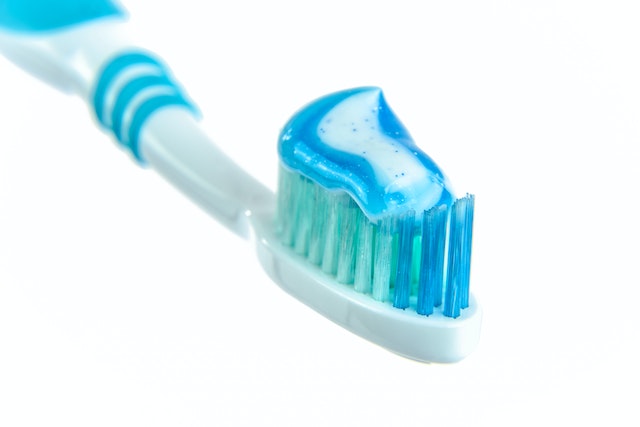
What is in toothpaste? It usually has fluoride, abrasives, flavors, humectants, and detergents.
So, what do all of these things do? Fluoride is a naturally occurring mineral. It can be found in most places on Earth, and it is also present in our bodies. Our bodies use it to strengthen our bones and teeth. Fluoride is absorbed into the blood and carried to the bones. It has a very small radius, and it can fit into the spaces between the calcium and phosphate minerals that make up our bones. This increases the density of the bones and stabilizes them. It does the same thing in the enamel of our teeth.
Our teeth are made up of three parts. The inner part is called the pulp. It houses the nerves and blood vessels. (Incidentally, we have nerves in our teeth to allow us to feel hot and cold, but that is not the main reason. The nerves all over our body help us subconsciously know where every part of our body is at any moment. This is called proprioception. The reason you know when something is stuck in your teeth is because of these nerves.) The next layer of the tooth is dentin. It is softer than enamel and gives the tooth its shape. It is only 70% mineral. The outer surface is the enamel, which is the hardest substance in the body. It is 96% mineral and is mostly made of calcium and phosphate. Remember, the fluoride can get between these to strengthen the enamel. Some animals’ teeth grow all through their lives and some animals grow replacement teeth, but we only have one set of adult teeth, so the fluoride in toothpaste helps them to be useful for longer. If the enamel fails, the softer dentin can decay very rapidly, forming a cavity.
Many people worry that fluoride is dangerous, but it isn’t. There is naturally fluoride in almost everything we eat and drink. However, like any mineral, too much of it can be fatal. The American Government recommends no more than 10 mg a day, and to aim for about 4 mg. A fatal dose of fluoride would be about 10 g. Every time you brush your teeth, you use about 1.3 mg, but most people don’t swallow their toothpaste, so you won’t ingest much of that. You would have to eat about 10 kg of toothpaste for it to be fatal, and I’m not sure that the fluoride would be the only reason you died.
Because cavities are becoming such a large problem in our societies now that we eat so much sugar, a lot of countries have started to fluorinate their water supplies. This is generally about 0.7 mg per liter. So, again, as long as you’re not drinking more than 5 liters of water a day, it is only a good thing.
The abrasives help to remove food debris, surface stains, and plaque from your teeth. They are usually minerals like calcium carbonate or silica. They scratch the enamel a little, but this is an accepted side effect of removing the food debris that can cause cavities.
The flavors are what make the toothpaste taste nice and leave you with the clean fresh feeling in your mouth. Without the flavors, toothpaste would taste pretty nasty. They are usually flavored with a mint oil. The menthol in the mint oil can activate the nerve cells in your mouth that are triggered by cold, which tricks your brain into thinking your mouth is cold and it feels fresh.
The humectants stop the toothpaste from drying out. Things like glycerol, xylitol, and sorbitol are added because they trap water inside. Sorbitol is a sugar alcohol, so it has a sweet taste as well as stopping the toothpaste from becoming a powder. It is not actually a sugar, though, so it doesn’t cause cavities.
Lastly, the detergent is added to make the toothpaste foam up. This is usually sodium lauryl sulfate, which is also used in shampoo and washing detergent. It is great for removing oils and residues and when it foams up, it ensures the toothpaste coats all of the teeth. Sodium lauryl sulfate is not hazardous in small doses, but you shouldn’t start drinking your shampoo.
The Egyptians started using toothpaste in about 5000 BC. They made it from powdered ox hooves, eggshells, and pumice. Modern toothpaste was invented in the 18th century and the Colgate company formed in 1873. Fluoride was added in 1890 and striped toothpaste was invented in 1955.
So, what is in toothpaste? Toothpaste contains ingredients to strengthen enamel, remove oils and food debris, make the toothpaste foam up, and to taste good. And this is what I learned today.
Sources
https://en.wikipedia.org/wiki/Toothpaste
https://www.sciencedirect.com/topics/chemistry/toothpaste
https://en.wikipedia.org/wiki/Human_tooth
https://en.wikipedia.org/wiki/Fluoride
https://www.healthline.com/health/what-is-fluoride
https://ec.europa.eu/health/scientific_committees/opinions_layman/fluoridation/en/l-3/2.htm
https://www.humana.com/dental-insurance/dental-resources/tooth-enamel
https://ods.od.nih.gov/factsheets/Fluoride-HealthProfessional/
